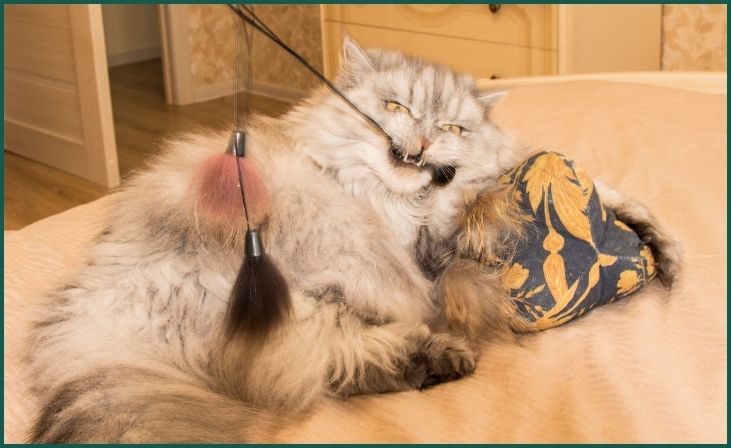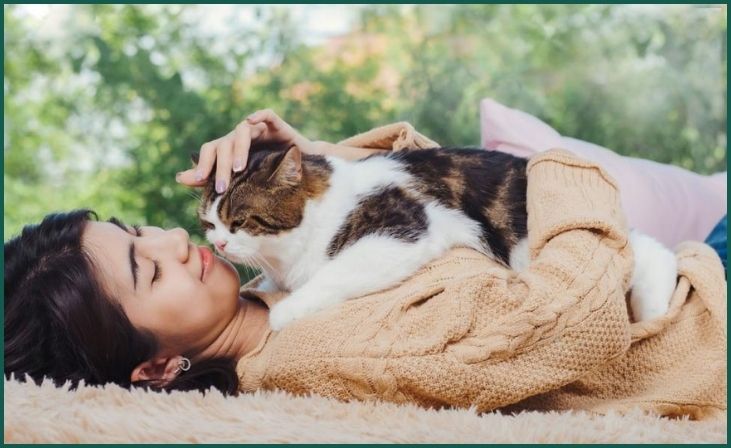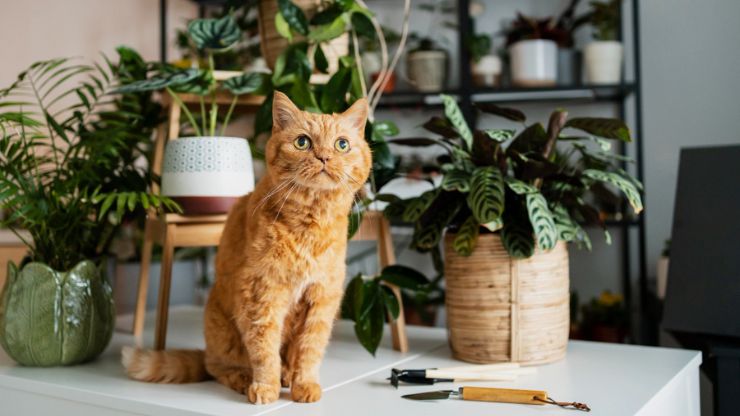Welcoming a cat into your home is a delightful experience, but ensuring their happiness and well-being is key to a harmonious relationship. Cats are unique creatures with specific needs and preferences that, when met, can lead to a contented and joyful feline companion. In this blog, we’ll explore seven essential elements that contribute to a happy cat. From providing enriching environments and engaging playtime to offering nutritious meals and creating safe spaces, these tips will help you understand what makes your cat tick. Whether you’re a new cat owner or looking to enhance your current feline friend’s happiness, incorporating these strategies into your daily routine can lead to a purring, playful, and emotionally fulfilled kitty. Join us as we delve into the secrets of feline happiness and discover how to create a purrfectly blissful life for your beloved cat.
Table of Contents
ToggleThings to Make Your Cat Happy
1. Get a Really Nice Scratching Post:

A high-quality scratching post is more than just a piece of furniture; it’s a necessity for your cat’s well-being. Cats have a natural instinct to scratch to keep their claws healthy, mark their territory, and stretch their muscles. Investing in a sturdy and appealing scratching post will redirect your cat’s scratching behavior away from your furniture and carpets, saving them from potential damage and you from frustration. Look for posts made from sisal, cardboard, or wood, and ensure it’s tall enough for your cat to fully stretch out. Place the scratching post in a prominent and accessible location, and entice your cat to use it by rubbing catnip or dangling toys nearby. With a proper scratching post, your cat will stay entertained and satisfied while keeping your home intact.
Also Read- 8 Best Hiking Dogs of All Sizes To Keep You Company on the Trail
2. Help Your Cat Stay Groomed:
Regular grooming sessions are not only beneficial for your cat’s appearance but also for their overall health and well-being. Brushing your cat’s coat helps remove loose fur, dirt, and tangles, reducing shedding and preventing hairballs. It also stimulates circulation and distributes natural oils, keeping their skin and fur healthy. Use a soft-bristled brush or comb suitable for your cat’s coat type, and make grooming sessions a positive experience by offering treats and gentle praise. Additionally, trim your cat’s nails regularly to prevent them from becoming too long and causing discomfort or snagging on surfaces. Clean your cat’s ears with a damp cloth or specialized ear cleaner to remove wax and debris, reducing the risk of ear infections. By prioritizing grooming, you’ll keep your cat looking and feeling their best while strengthening your bond.
3. Treat Your Cat with Treats:
Treats are a delightful way to reward your cat for good behavior, encourage training, and simply show them love and appreciation. However, it’s essential to choose treats that are not only tasty but also nutritionally balanced and appropriate for cats. Look for treats made with high-quality ingredients, free from artificial additives and fillers. Treats should complement your cat’s regular diet and not exceed 10% of their daily caloric intake to avoid overfeeding and weight issues. Use treats strategically during training sessions to reinforce positive behaviors, such as using the scratching post or coming when called. Additionally, consider interactive treat-dispensing toys that provide mental stimulation and challenge your cat’s problem-solving skills while rewarding them with tasty treats. With moderation and the right treats, you can keep your cat happy and healthy.
4. Give Your Cat New Toys:

Toys are essential for keeping your cat mentally and physically stimulated, preventing boredom, and encouraging healthy behaviors. Provide a variety of toys that cater to your cat’s instincts and preferences, such as interactive toys that mimic prey movements, catnip-filled toys that stimulate playfulness, and feather wands that activate their hunting instincts. Rotate toys regularly to keep them engaging and exciting, and introduce new toys periodically to prevent boredom. Cats often enjoy toys that encourage chasing, pouncing, and batting, so choose toys that allow for active play and mimic natural hunting behaviors. Keep toys accessible and accessible in different areas of your home to encourage exploration and play. By providing a stimulating environment with plenty of toys, you’ll keep your cat entertained and happy while fostering their physical and mental well-being.
Don't just scroll, subscribe!
BuzzTrail's unique web-stories are the cure for boredom you've been waiting for.
5. Refresh Your Cat’s Water Dish:
Proper hydration is essential for your cat’s health, and ensuring they have access to clean and fresh water at all times is crucial. Cats may be hesitant to drink stagnant water, so regularly refreshing their water dish is essential to encourage them to stay hydrated. Consider using a wide and shallow water dish that allows easy access and prevents whisker stress. Alternatively, invest in a cat water fountain that mimics flowing water, which can be more enticing for cats and encourages them to drink more. The constant movement of water in a fountain also helps prevent bacteria growth and keeps the water oxygenated and fresh. Place the water dish or fountain in a quiet and accessible location away from their litter box and food bowls. By providing clean and appealing water sources, you’ll help your cat stay hydrated and healthy.
6. Upgrade Your Cat’s Throne (Litter Box):
A clean and comfortable litter box is essential for your cat’s bathroom habits and overall well-being. Cats are naturally clean animals and prefer a tidy and odor-free environment for eliminating waste. Choose a litter box that is spacious enough for your cat to move around comfortably and has low entry sides for easy access, especially for kittens or older cats. Consider using unscented clumping litter that is gentle on your cat’s paws and makes cleaning the box more manageable. Regularly scoop the litter box at least once a day to remove waste and clumps, and completely replace the litter and clean the box weekly. Provide multiple litter boxes if you have multiple cats to prevent territorial issues and ensure each cat has a designated bathroom space. By maintaining a clean and inviting litter box, you’ll encourage proper litter box usage and prevent accidents or aversions.
7. Spend Some Extra Time Cuddling Together:

Affection and companionship are vital for your cat’s emotional well-being and overall happiness. Cats are social animals that thrive on bonding with their human companions, and spending quality time together strengthens your relationship and provides comfort and security for your cat. Set aside dedicated time each day for cuddling, petting, and interacting with your cat in a calm and reassuring manner. Learn your cat’s preferences for affection, such as gentle strokes, chin scratches, or lap cuddles, and respect their boundaries and cues. Use positive reinforcement, treats, and soothing words to create a relaxing and enjoyable experience during cuddle sessions. Additionally, provide cozy and inviting spaces, such as cat beds, blankets, or soft furniture, where your cat can curl up and relax near you. By prioritizing quality time and affection, you’ll nurture a strong bond with your cat and ensure they feel loved and content in their home.
For More- 8 Dog Breeds That Look Like Puppies Forever
Conclusion
Ensuring your cat’s happiness involves addressing their physical, mental, and emotional needs through various aspects of care and interaction. From providing essential items like scratching posts and litter boxes to offering affection, grooming, and stimulating activities, each element contributes to a fulfilling and joyful life for your feline friend. By incorporating these seven strategies into your daily routine and understanding your cat’s unique preferences and behaviors, you’ll create a nurturing environment where your cat can thrive and flourish. Remember that every cat is different, so observe and adapt to your cat’s responses and needs to tailor their care and ensure their ongoing happiness and well-being.
FAQs
How often should I groom my cat?
How often should I groom my cat?
Grooming frequency depends on your cat’s breed, coat length, and shedding tendencies. Generally, cats with longer hair require more frequent grooming, ideally several times a week, while short-haired cats may need grooming once a week.
What type of treats are safe for cats?
What type of treats are safe for cats?
Look for cat treats made from high-quality ingredients and specifically formulated for cats. Avoid treats with artificial additives, excessive fillers, or ingredients that cats may be sensitive to, such as grains or dairy.

